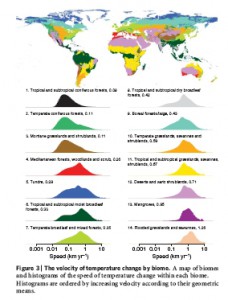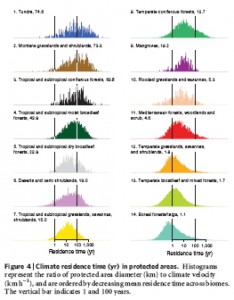![]() Well, in terms of distance along the Earth’s surface, about 400 m per year on average, ranging from 80 m per year in mountainous regions to 1.26 km per year in deserts. That’s according to a new paper in Nature by Loarie et al. ((Loarie, S., Duffy, P., Hamilton, H., Asner, G., Field, C., & Ackerly, D. (2009). The velocity of climate change Nature, 462 (7276), 1052-1055 DOI: 10.1038/nature08649)) Compare that with figures of postglacial migration rates of <100 m per year for some trees. Here’s a map of the speed of temperature change by biome from the Nature paper (click to enlarge).
Well, in terms of distance along the Earth’s surface, about 400 m per year on average, ranging from 80 m per year in mountainous regions to 1.26 km per year in deserts. That’s according to a new paper in Nature by Loarie et al. ((Loarie, S., Duffy, P., Hamilton, H., Asner, G., Field, C., & Ackerly, D. (2009). The velocity of climate change Nature, 462 (7276), 1052-1055 DOI: 10.1038/nature08649)) Compare that with figures of postglacial migration rates of <100 m per year for some trees. Here’s a map of the speed of temperature change by biome from the Nature paper (click to enlarge).
And here’s the “persistence time” for protected areas in different biomes, i.e. the diameter of protected areas divided by the climate velocity.
The persistence time — which is how long it takes for the current climate to cross a protected area — exceeds 100 years for only about 8% of protected areas. And that, dear reader, is why we need protected areas that are larger and more connected. Oh, and genebanks.

